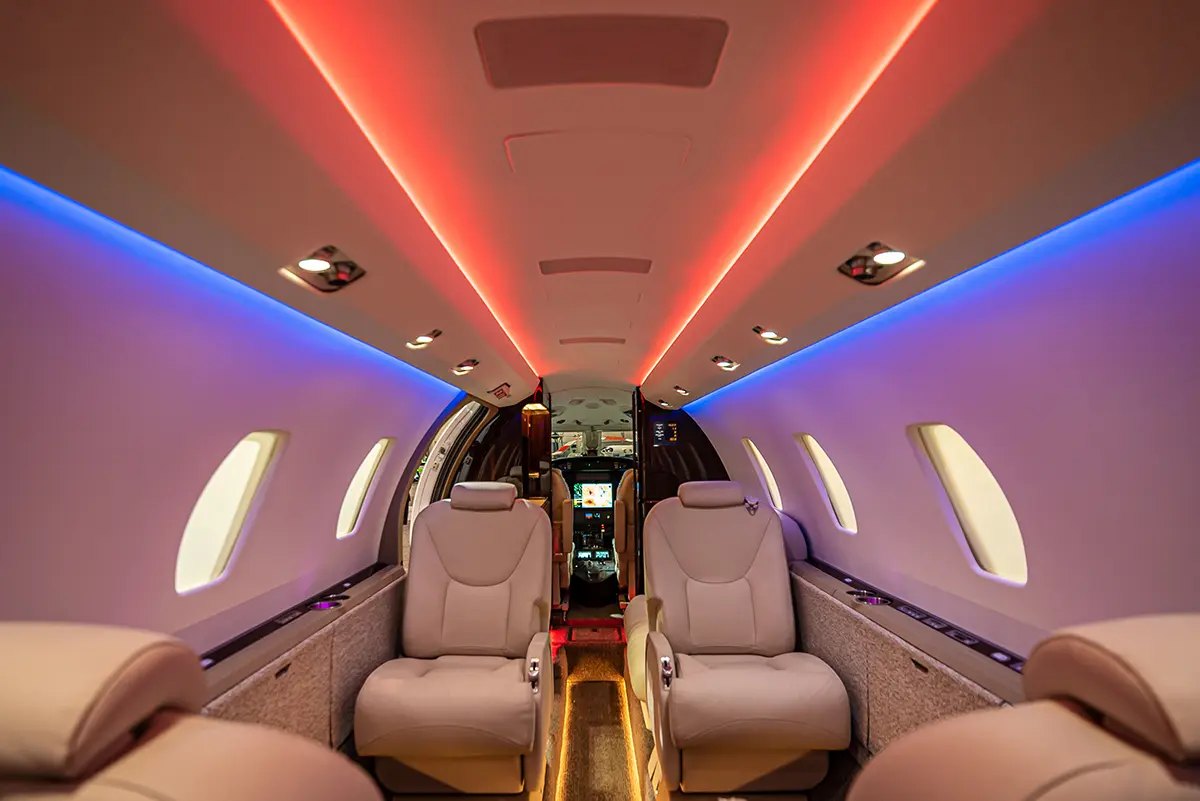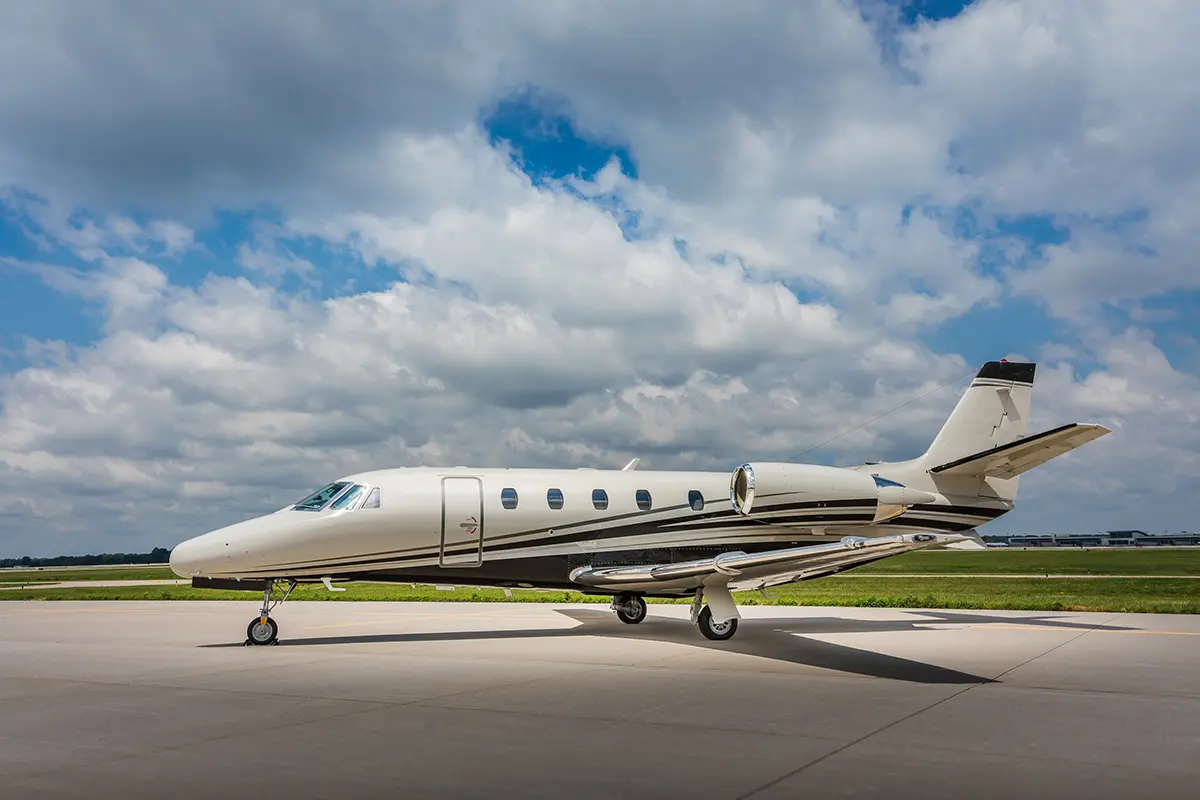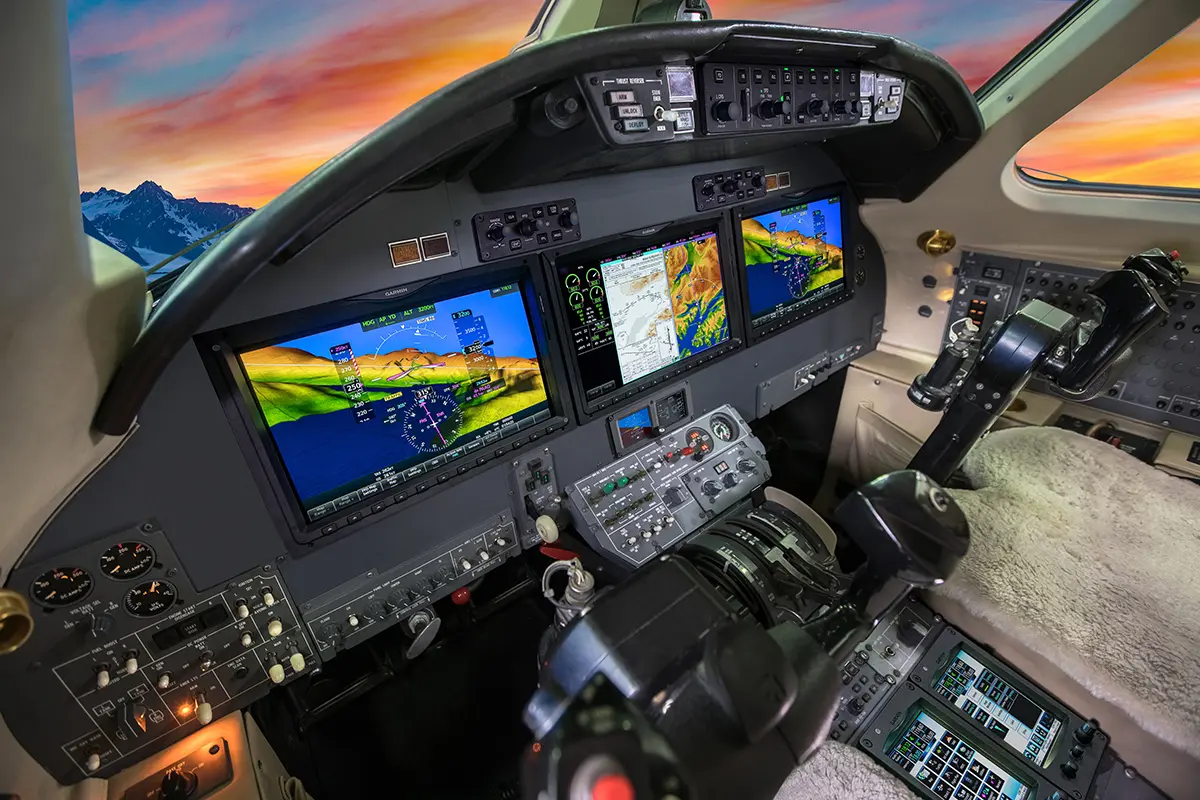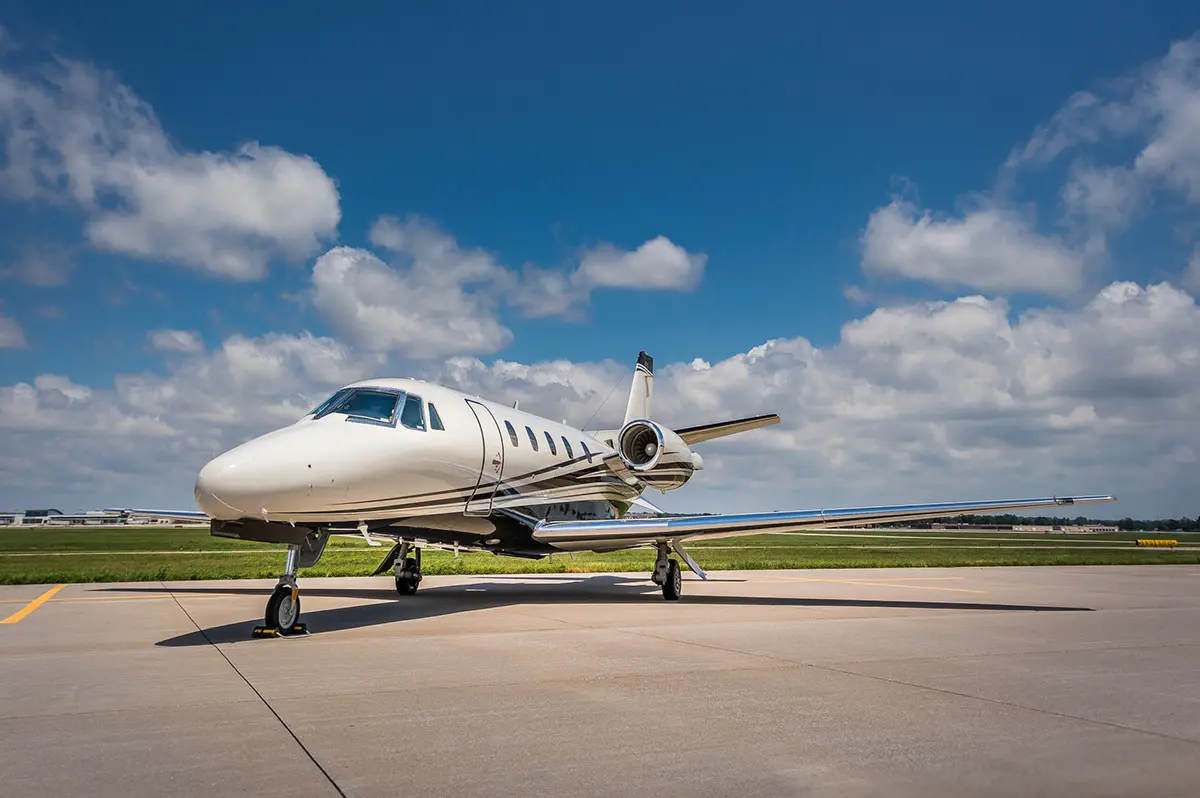
Since nearly the dawn of the 20th century, Cessna has been a leader in the design, production, and manufacture of aircraft. Its Citation family of business jets has been enduringly popular since the first model debuted over fifty years ago. The best-selling midsize models are the 560XL series, encompassing the Citation Excel, the Citation XLS, and the Citation XLS+. These models combine sleek style, transcontinental range, and remarkable efficiency—the Cessna brand’s hallmarks for more than a century.
Cessna is the epitome of an all-American success story.[1] Clyde Cessna was a Kansas farmer with a passion for aviation and a talent for construction. He built and flew his first aircraft from wood and fabric in June 1911, not even a decade after the Wright Brothers’ first successful flight. Clyde tweaked and tested his creations over the barren Oklahoma salt flats, which offered him plenty of room to soar (and crash land). In 1927, he and a partner founded the Cessna-Roos Aircraft Company in Wichita, Kansas. Although his partner left almost immediately, the company successfully produced its first commercial aircraft, the Cessna DC-6, by 1929.
Although the Great Depression caused the company to stop production in 1932, its Cessna CR-3 custom racer was already finished when the doors to the factory swung shut. The CR-3 made its debut in 1933, winning the American Air Race in Chicago and setting a new world speed record for engines under 500 cubic inches (clocking an average of 237 mph (381 km/h)). Clyde’s nephews purchased the company in 1934 and restarted production, injecting new capital and enthusiasm into Cessna’s aviation offerings.
In addition to continuing production of the DC-6 aircraft, Cessna began to innovate new designs. It introduced the C-37 seaplane model in 1937. By 1940, the company had built an excellent reputation along with its portfolio of aircraft. Its fortunes continued to thrive when the U.S. Army placed an order for 33 custom Cessna T-50s; a few months later, the Royal Canadian Air Force commissioned a staggering 180 units of the T-50 model. For the next six years, along with the rest of the world, Cessna focused its attention on military production.
When World War II drew to a close, Cessna returned to commercial production. It introduced the Model 120 and Model 140 planes in 1946; these all-metal aircraft used the assembly-line techniques perfected during the war to streamline production and improve product consistency. Both of these light general aviation aircraft were single-engine, two-seat planes with conventional tailwheel landing gear. Replacing the fabric in the wings with light-gauge sheet aluminum improved the crafts’ performance and eliminated the need for periodic wing replacement.
Over the next few decades, Cessna introduced its first helicopter, the CH-1 (certified by the FAA in 1955), and the Cessna 172 Skyhawk, which would become the most produced airplane in history. Its 50,000th plane rolled off the assembly line in 1963. In 1969, the company debuted the patriarch of the Citation family of business jets, the Cessna Citation I. Together with the Skyhawk (which remains, to this day, one of the most popular training craft for new pilots), the production of the Citation I catapulted Cessna to the highest ranks of the global aircraft industry.[2]Although the brand is now wholly owned by Textron, it continues to produce bestselling light and midsize general aviation aircraft and business jets in its Kansas and Mexico production facilities.

All of the aircraft in the Citation family are twin-engine business jets. The current portfolio of models still in production encompasses the Cessna Citation 525 M2/CJ series (in production since 1991), the 560XL Excel (since 1996), the 680 Sovereign (since 2004), the 680A Latitude (since 2014), and the 700 Longitude (since 2017). Announced in October 1994, the Model 560XL (officially called the “Excel” but frequently referred to in shorthand by its call letters, XL) first flew on February 29, 1996. The FAA certified it in April 1998.
The Citation Excel design was the culmination of Cessna’s design and production team consulting with its customers and incorporating their feedback. Clients loved the generous cabin width and standup headroom comfort of the Citation X, one of Cessna’s much larger business jets. Cessna’s engineers took the Citation III, VI, and VII designs back to the drawing board, shortening the fuselage but retaining the interior’s spaciousness for the new, smaller jet design.[3] These efforts paid off: the Citation Excel has one of the roomiest cabins of any midsize business jet, including 11 windows for ample natural light, standup headroom, and a dropped, full-length aisle.[4] Its cabin measures 18.7’ long by 5.5’ wide by 5.7’ tall, with a total cabin volume of 461 cubic feet, comfortably accommodating eight passengers in its standard configuration.
Cessna married its dedication to passenger comfort with new advances in engine and airframe technology. The Citation Excel design incorporated some of the best features of other Citation family designs, including a modified unswept supercritical wing based on the design of the Citation V Ultra and a cruciform tail configuration like that of the Citation V. It also included two top-of-the-line, next-generation Pratt & Whitney Canada PW-545A series turbofan engines. These 16.9kN (3804lb) PW-545As (derated from 19.9kN/4450lb, with a TBO of 5000 hours) came with standard thrust reversers. The Citation Excel has a cruise speed of 422 knots, a range of 1,839 nautical miles, a climb rate of 3,790 feet per minute, and requires approximately 3,959 feet of runway to takeoff and 3,755 to land.[5] Its ability to take off and land on short runways allows its passengers access to many difficult-to-access locations worldwide.
Cessna built 374 of the original model of Citation Excel between 1996 and 2004, at which time it introduced the upgraded Citation XLS. While the original Citation Excel came standard with the Honeywell Primus 1000 three-screen EFIS avionics package (two Primary Flight Displays, one for each pilot, and a multifunction display), the new version sported a modern “glass cockpit” avionics package. This upgrade traded the traditional analog gauge-and-dial instrument panel for the Honeywell Primus 1000 EFIS avionics suite, including all-digital flight instrument displays.
In addition to an improved avionics package, the Citation XLS also got a performance boost, trading up the original engines for a pair of Pratt & Whitney Canada PW-545B turbofans. These allow a normal cruise speed of 422 knots, a range of 1,989 nautical miles, and a climb rate of 3,500 feet per minute (while burning ten fewer gallons of fuel per hour than the Citation Excel). It requires 3,812 feet of runway to takeoff and 3,619 to land. Cessna produced 330 Citation XLS model aircraft before switching production to the Citation XLS+ edition.[6]
The Citation XLS+ features full authority digital engine/electronics controls (FADEC), even more powerful and efficient PW545C engines, and a completely revised nose design reminiscent of the Citation Sovereign and Citation X configurations. Citation XLS+ models also feature Collins Pro Line 21 Avionics and a four-screen LCD EFIS display (upgraded from the three-screen LCD configuration of the XLS). These allow the flight crew to enter flight data such as wind conditions, runway length, and cruise altitude into the flight management system (FMS) to optimize the aircraft’s performance and handling. These extraordinary advances in technology and avionics make the aircraft even more fuel-efficient, increase safety, and improve the pilot’s overall flying experience.
The new Citation XLS+ design also again increased the power and efficiency of the engines, outfitting the craft with two Pratt & Whitney Canada PW545C series engines. Its maximum cruise speed is 441 knots, with a range of 2,100 nautical miles and a climb rate of 3,500 feet per minute. The XLS+ requires approximately 3,560 feet of runway to takeoff and 3,619 to land.[7] The XLS+ remains in production.

Each of the 560XL series model upgrades focused mainly on increasing power, improving efficiency, and upgrading the craft’s avionics technology rather than making cosmetic changes. The popular cabin design is essentially the same on all three models, although the classic styling can now be augmented with available modern conveniences like WiFi. Seating and storage configurations can accommodate up to a maximum of 12 passengers and 800 pounds/90 cubic feet of baggage. Luxurious cabin retrofits can customize the space to your personal style and business needs, with a wide variety of top-quality finishes, fabrics, lighting, sound, and entertainment packages to choose from.
There are a comparable number of midsize business jets to the Citation 560XL series, including the Hawker 850XP, the Hawker 900XP, the Lear 45XR, or the Lear 60XR. While the Citation 560XL series lacks the range of the Hawker aircraft and the speed of the Lear jets, the operating costs for all 560XL models are lower. The 560XL series aircraft also offer external baggage capacity, and their short runway requirements allow better versatility for landings in more locations. The balanced combination of style, performance, and economy makes all of the Citation 560XL series aircraft bestselling choices in the midsize business jet category.[8]
One of the standout qualities of the Citation 560XL series is its long-term reliability, dependability, and retention of value. According to Cessna, the company has delivered more than 1,000 560XL series aircraft, and 99.4 percent remain in operation.[9] Factory service centers are located across the United States, and Textron has multiple service trucks for mobile onsite support.
In 2018, Textron assigned new production Citation XLS+ aircraft to a revised maintenance interval program designed to reduce aircraft downtime for required scheduled maintenance events. It extended the existing schedule is now extended to 12 months or 800 hours (from 12 months/600 hours), lengthening the time allowed for the completion of inspection documents and other required maintenance tasks like minor engine inspections. Some other tasks were also regrouped to eliminate dual intervals. The new interval schedule can also be applied to older Citation 560XL models with a Textron Aviation service bulletin.
Compared to the scheduled maintenance requirements of comparable aircraft, the Citation XLS+ jet allows operators up to 200 hours longer before each scheduled maintenance event. These longer intervals mean fewer service interruptions and added utilization.

The Garmin G5000 system is available as a state-of-the-art upgrade to replace the existing Honeywell Primus 1000 avionics in the Citation Excel and Citation XLS. The suite includes a new autopilot, wide-area ADS-B, augmentation system/localizer performance with vertical guidance (WAAS/LPV), electronic charts, engine monitor data, SafeTaxi, SiriusXM weather, and emergency descent mode. It also comes with additional options, including synthetic vision, underspeed protection, Chart view, turbulence detection, controller pilot datalink communications, and lighting and hail prediction, and includes a three-year warranty.
More than 150 Citation Excels and XLS are already equipped with Elliott Aviation’s ADS-B STC, which qualifies them for a $50,000 credit toward the equipped aircraft’s G5000 system. A full-cockpit avionics retrofit adds value, improves safety and pilot comfort, and increases the craft’s longevity for resale.[10]

Purchasing a midsize business jet-like one of the Citation 560XL series models allows your business to reduce or eliminate travel on commercial airlines. This can reduce flight delays, potential exposure to health hazards, security delays, and other hassles. The efficient, versatile operation of the Citation 560XL models can also help reduce vehicular travel, allowing your employees to fly to remote locations that may not have commercial airline access. This can save countless hours of wasted time and money. Having your own business jet enables you to travel in comfort, conduct business privately and efficiently, and arrive at your destination refreshed and ready to go.
Businesses can generally depreciate aircraft used for qualified business purposes, like Part 91 business use flights, under a modified accelerated cost recovery system over a period of five years. Alternately, businesses may use the alternative depreciation system with a six-year recovery period. (Owners should take note that using the aircraft for non-business purposes in addition to business-related travel can impact the allowable amount you can deduct yearly for depreciation; consult with a tax professional for more specific information.) Additionally, the 2017 Tax Cuts & Jobs Act can allow qualified individuals and businesses to deduct up to 100 percent of the cost of a new or used aircraft purchased after September 27, 2017, and placed into service before January 1, 2023. These incentives increase the benefits and cost savings of buying any business jet, including one of the Cessna Citation family of aircraft.
Overall, the Citation 560XL series aircraft have lower maintenance costs, lower operating costs, and better efficiency than the average medium business jet.[11] However, because of its excellent retention of value, the purchase price of all three models (the Citation Excel, the Citation XLS, and the Citation XLS+) tend to be higher than comparable aircraft. These aircraft are an economical choice for regular, frequent use that doesn’t sacrifice performance, comfort, or style. For many users, the operational cost savings often significantly outweigh the higher purchase price in a very short period of time.
If you’re contemplating purchasing a Citation Excel, Citation XLS, or Citation XLS+ and want to learn more about the Cessna 560XL family of jets, contact Elliot Jets today. We can help you find the perfect aircraft for your company’s needs, locate the best model at the right price, and customize your purchase with the stylish and technological upgrades that are right for your business.
At Elliott Jets, we’ve sold and acquired many Citation Excel, Citation XLS, and Citation XLS+ jets for customers all over the world. Our parent company, Elliott Aviation, is a 145 repair station for 560XL series aircraft. If you’d like to purchase a Citation Excel, Citation XLS, or Citation XLS+ jet or other business aircraft, talk to one of our experienced representatives today.
[1] “About Cessna–History.” Cessna. Archived at www.waybackmachine.com. Retrieved 28 Jan 2021.
[2] Goyer, Isabel and Flying Staff. “Cessna 172: Still Relevant Today?” Flying Magazine, 29 Jan 2020. www.flyingmag.com. Retrieved 29 Jan 2021.
[3] “A Comprehensive Review of the Citation XLS.” YouTube, uploaded by Elliot Jets, 5 Jan 2021. https://www.youtube.com/watch?v=ccrk9MCbT98&feature=youtu.be.
[4] “Cessna 560XL Citation Excel.” Airliners.net. Retrieved 29 Jan 2021.
[5] Sparks, Keith. “The History of Cessna Citations: Excel, XLS, XLS+.” Charlie Bravo Aviation, 9 Jun 2017. blog.wepushtin.com. Accessed 29 Jan 2021.
[6] Ibid.
[7] Ibid; “Citation XLS+.” Cessna by Textron Aviation. Accessed 29 Jan 2021.
[8] “A Comprehensive Review of the Citation XLS.” YouTube, uploaded by Elliot Jets, 5 Jan 2021; Lynch, Kerry. “Elliott Sells First G5000-equipped Citation 560XL.” AINOnline.com. Accessed 20 Jan 2020.
[9] “A Closer Look at the Citation XLS+.” Cessna by Textron Aviation. Accessed 29 Jan 2021.
[10] Lynch, Kerry. “Elliott Sells First G5000-equipped Citation 560XL.” AINOnline.com. Accessed 20 Jan 2020.
[11] “Cessna Citation Excel 560XL Operating Costs.” Prijet.com. Accessed 29 Jan 2021. See also AircraftCostCalculator.com, “CESSNA Citation Excel Price and Operating Costs,” “CESSNA Citation XLS Price and Operating Costs,” and “CESSNA Citation XLS+ Price and Operating Costs.”